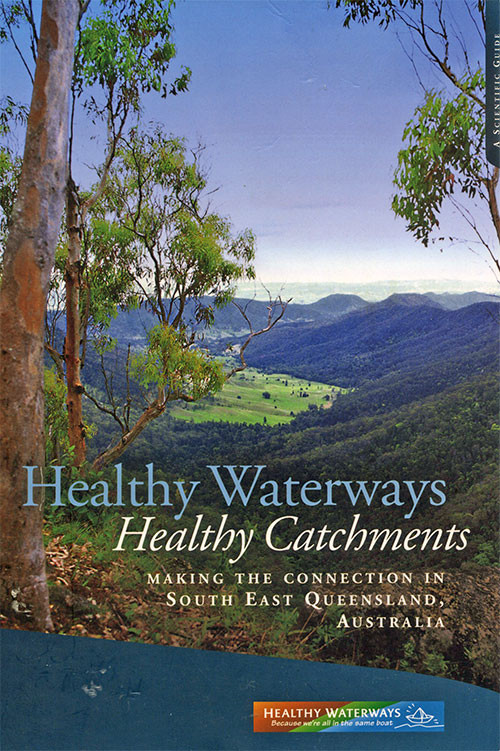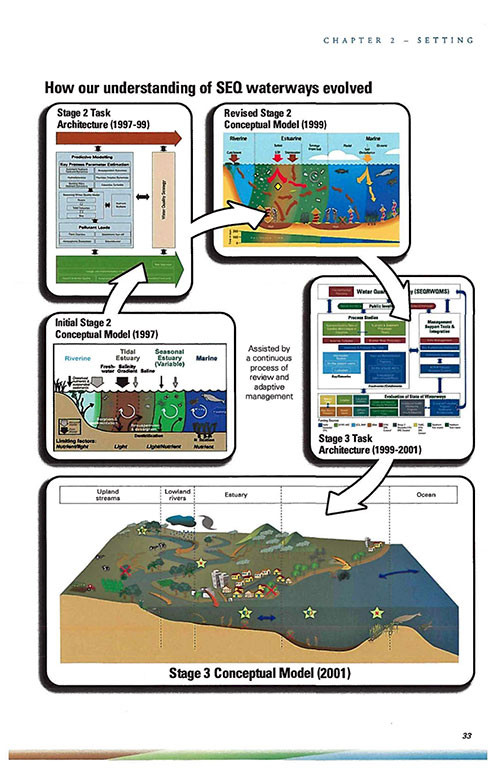Healthy Waterways Healthy Catchments: Making the connection in South East Queensland, Australia
Bill Dennison ·Healthy Waterways Healthy Catchments is now available for free in PDF format from IAN press.

This 238 pp. book was the fourth in a series of four books produced as part of the Healthy Waterways campaign in Southeast Queensland. It was published in 2005 and summarized the scientific findings from a variety of different projects that were conducted as part of Phase 3 of the Healthy Waterways program. This book had a similar format as its predecessor, Moreton Bay Study: A Scientific Basis for the Healthy Waterways Campaign. Both books had conclusions and recommendations at the beginning, incorporated active titles, and were richly illustrated with various visual elements (conceptual diagrams, photos, maps, figures and tables). However, there were several important differences in books; Healthy Waterways Healthy Catchment covered an expanded geographic region, was co-authored by a much larger group of scientists (a full four pages were used to list contributors) and incorporated monitoring, modeling and research results, instead of almost exclusively research results.
The process of developing the outline for this book was a storyboard workshop held at the Moreton Bay Research Station on Stradbroke Island. The lead authors for each chapter developed an active title and sketched the supporting material for each page on an A4 piece of paper. These pages from each chapter were taped up on a large wall of the research station. This 'wallpaper' was viewed by all of the chapter authors and various pages were rearranged and modified as a result of discussion and negotiation between chapter authors. This broad overview allowed everyone to scope out their chapter within the context of the entire book, and go off to populate their pages based on this storyboard outline. We were able to initiate and complete the predecessor book, Moreton Bay Study, in a more timely fashion due to the limited authorship. In Healthy Waterways Healthy Catchments, the longer production time was due to the expanded list of co-authors, but this allowed for a higher level of integration.

The overall conclusion of the book was 'healthy catchments lead to healthy waterways' which was reflected in the book title. One of the strategies in assembling the material for this book was to focus on topics (e.g., sediments, nutrients, habitats) and integrate terrestrial, freshwater and marine aspects, rather than having separate geographic sections. The broader geographic footprint covered by this book reflected the ecological footprint of Southeast Queensland, including the metropolitan Brisbane urban areas, the agriculture and drinking water resources, and recreational areas including the Sunshine and Gold Coasts. One chapter was devoted to the development of an Environmental Management Support System (EMSS), which was an interactive modeling approach to create various scenarios with diverse stakeholders and was a major thrust of Stage 3. Another chapter was devoted to the harmful algal blooms (HAB) of Lyngbya, a filamentous cyanobacteria blooming in Moreton Bay. Another chapter described the Ecosystem Health Monitoring Program, with its expanded scope to include freshwater, estuarine and bay monitoring.
The book chapters for Healthy Waterways Healthy Catchments were the following: Setting, Aquatic habitats, Sediments, Nutrients, Lyngbya, Ecosystem Health Monitoring Program, Integration and The Way Forward. Each chapter had both catchment and bay or ocean components. A reflection of the density of scientific results packed into this book is the single pages that summarize key findings by University of Queensland graduate students. In particular, part of Ian Hewson's Honours thesis (p. 66) and Kathy Chaston's PhD dissertation (p. 61) are summarized onto single pages. Both Ian Hewson (now at Cornell University) and Kathy Chaston (NOAA in Hawaii) continue to be productive scientists who incorporate their excellent science communication skills into their efforts.

Overall, the four books introduced in this blog series provided everyone involved in the Healthy Waterways effort a) an invitation to become involved and b) a scientific basis for understanding the issues and approaches and c) an outline of the research, monitoring, modeling and management strategies being undertaken. Thus, the books became tools to aid recruiting new people, provide synthesized information for informed decision making and help chart out future activities. They were all popular, inexpensively disseminated, and are currently out of print. This was motivation to provide them as PDFs on the web so that they can be accessed by people in Southeast Queensland as well as elsewhere, where they can serve as models for other regions.
About the author
Bill Dennison

Dr. Bill Dennison is a Professor of Marine Science and Vice President for Science Application at the University of Maryland Center for Environmental Science.

